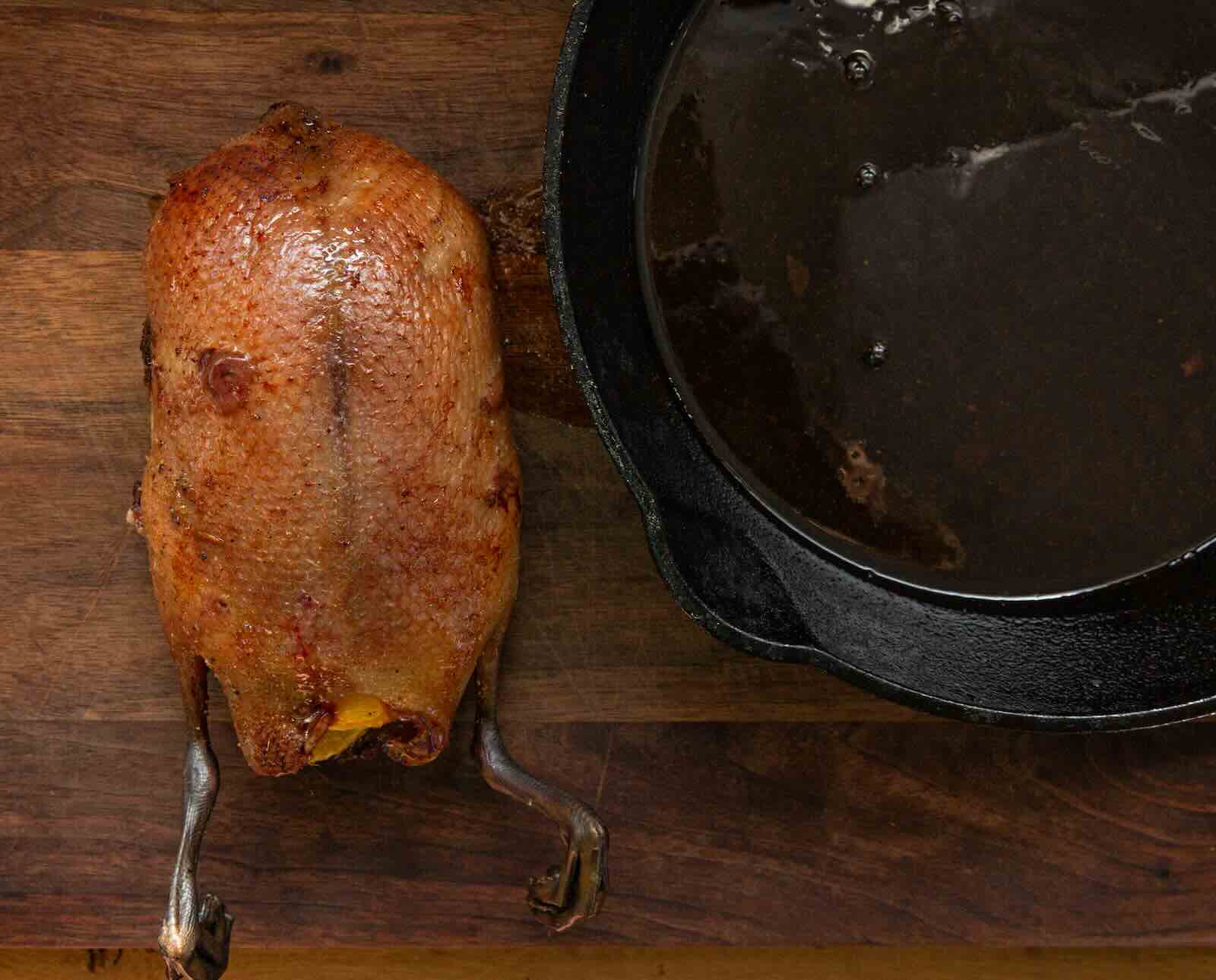Roast Gadwall

Best practices for brining and oven-roasting wild Gadwall ducks
Gadwall belong to the group of wildfowl often lovingly referred to as “puddle ducks.” Other puddle ducks include mallards, wood ducks, teal, and pintails. Unlike “divers,” puddle ducks do not dive beneath the water’s surface. They don’t feast primarily on invertebrates or small fish. Instead, puddle ducks feed on aquatic plants and, oftentimes, seeds or grain. Invertebrates and fish are what give divers their strong flavor. Although puddle ducks have a better culinary reputation than divers, roasted puddle ducks can still taste like the bottom of a pond if they’re not prepared properly.
What sets a gadwall apart from other ducks regarding its culinary attributes? What are the steps necessary to properly roast a wild gadwall? Let’s break it down.
More Often Than Not, Brine Puddle Ducks Twice
Saltwater brine solutions draw out residual blood. The removal of blood is very important for wild ducks. Too often I have simply salted a wild duck that looks pristine upon inspection. Then, upon my first bite, I realized just how much blood that cut still had inside.
Residual blood in wild duck meat can make your meal taste like scuzzy pond water—yes, this is true even for puddle ducks.
A bloody duck that gets frozen without being brined first will marinate in its not-tasty blood as it thaws—not ideal. If you are planning to freeze your gadwall before cooking it, brine it in one gallon of cold water with ½ cup kosher salt for 3 to 6 hours first. When you remove the duck from the brine, thoroughly rinse off the brine with fresh water.
Even if you brine your ducks before freezing them, it doesn’t hurt to brine them a second time after they thaw. The final brine will assist with removing blood and adding flavor. Brines help meat retain moisture while cooking, too.
Although a brine will slightly mellow out a gadwall’s innate wild flavors, brining is still considered a best practice unless you’re absolutely positive that the cut of duck is devoid of blood.
What Does Wild Gadwall Taste Like?
Simply put, gadwall tastes like a puddle duck and is very similar to mallard. In my experience, gadwall does have more of a pond-water flavor (honestly, I don’t like using the word gamey). The meat is also a bit darker compared to other puddle ducks like teal, so it has a slightly wilder flavor.
Roasting A Wild Gadwall Whole
Mallards are the largest wild duck that can be roasted whole. Gadwalls, being slightly smaller, can certainly be roasted whole. However, some key steps are necessary. But even if these steps are followed, it is sometimes necessary to cut off the legs and wings and continue to roast them low and slow until they are tender.
Duck breasts are best served medium rare, or not much hotter than 130 F. Legs and wings need to reach 190 degrees over time to break down collagen and tenderize. If they don’t, they will be chewy and tough.
When roasting a wild duck whole, cooks want both crispy skin and properly cooked breasts, wings, and legs.
What’s my secret to roasting wild gadwall? Frozen fruit.

Ingredients
Method
- Mix the salt with the cold water and brine the whole duck for 8 hours.
- After you have brined and thoroughly rinsed off the duck under cold water, allow it to sit in the fridge with ample airflow to all sides for several hours. A dry duck will make for crispier skin when roasting.
- Hours ahead of roasting, cut the shape of the duck breast out of two navel oranges and freeze the breast-shaped pieces. Trim the rind off the cut-out pieces, too, and freeze those as well. You may wish to do this with two sets of two oranges; I’ll explain why shortly.
- When you are ready to roast, pre-heat your oven to 275 degrees. Cut your root vegetables or celery and create planks in your skillet.
- Set the duck breast-side-up on the planks, allowing for ample airflow on all sides. Stuff the duck’s cavity with the frozen orange slices. Then, place whole frozen oranges (with breast-shaped cuts removed) on top of breasts. You may need to secure the oranges with toothpicks to prevent them from sliding off.
- The frozen fruit will slow down the rate at which the breasts cook while also adding that orange flavor that pairs so well with duck. The orange slices inside its cavity do the same thing. (Think of how a stuffed Thanksgiving turkey cooks slower—the flow of heat is restricted and, therefore, the breasts cook more slowly).
- Roast the gadwall for at least 50 minutes. You may wish to swap out the frozen oranges at this point (this is where the second pair of frozen oranges comes in handy) and roast for another 30. Be careful not to burn the wings or legs.
- Once the sides of the duck are dark golden brown, remove the oranges and allow the duck to roast for 5 more minutes. Turn on broiler and broil for another 5 to crisp up the duck’s skin.
- The goal is to cook the duck breasts to about 140 F. Wings and legs should get closer to 190 F. It still may be necessary to throw the wings and legs back into the oven to tenderize. You can also make a glaze from the fat and orange drippings by adding a bit of honey to the skillet and mixing all the juices together.








